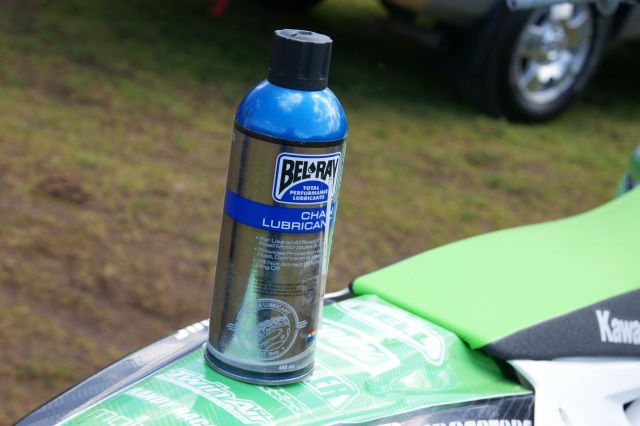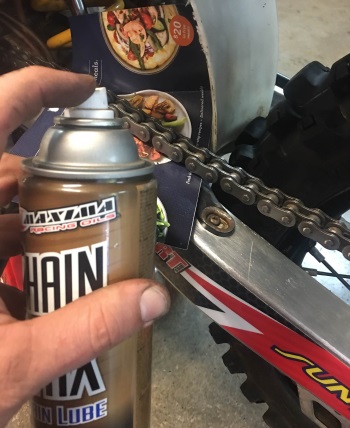
A well lubricated chain makes for an outstanding ride day and also extends the life of the chain and sprockets. But well-lubricated means more than an adequate coating.
You may have heard through backyard stories or perhaps have one yourself of alternative forms of lubrication some riders use on their chain because they have nothing else or they heard from their best friend's sister's boyfriend's brother's girlfriend who heard it from this guy who knows this kid who's going with a girl who mentioned it at 31 Flavors last night.
Used motor oil? Well that's a mess. Actually, soaking a chain in used oil has some redemptive values especially when unsticking a stuck chain because of all the rust. It works. Used oil also isn't a bad lubricant either at least in the short run. Unfortunately, used motor oil, even new oil, offers very little viscosity thus drips off and makes a mess everywhere. Once spinning that stuff spits off the chain and your bike looks more like an oil well rather than runs as a well-oiled machine.
And, if you have a rusty chain that needs cleaning and/or loosened, throw it out. You don't want to ride a defective chain. Rust = Defective. You might save a few bucks by extending its life but you also risk injury or damage to your bike because when those things snap they tend to slap the side of the crankcase leaving a big hole. Or they slap you leaving a whip mark not seen since the New Testament. So, instead of paying the $60 or $70 for a new chain you have a $500 crankcase half to purchase plus labor or you have a serious wound.
Vaseline or ball-bearing grease? All pretty much the same thing. One is for personal use the other for dirt bike and ATV use. Not an awful choice, but hardly good. The stickiness offered by these water proof grease substances offers solid coating capacity and either one probably holds on a bit longer than used oil however once these substances heat up expect a mess and protective properties to nose dive.
Pam? No, not the neighbor down the street or the girl from The Office. PAM. The cooking spray. PAM, basically an aerosol vegetable oil, lubricates frying pans and while other ingredients give it some stickiness don't expect this to work very well on your chain. Once again heat plays a role in diminishing its capacity and vegetable oil simply doesn't offer the strength to hold up in a powersports application.
Silicone lube? Works great on the chain that slowly opens and closes the garage door but hardly a good choice for lubricating the breakneck chain on a dirt bike or ATV. You'll love the heavy coating it offers but like grease and PAM once the chain heats up silicone lube turns into a sloppy mess.
WD-40? OK, now we have something. While WD-40 doesn't top the list in terms of proper lubrication for your chain and sprockets it works well in a pinch and many riders use this stuff exclusively. WD-40 offers great lubricating properties and stands up well to heat but you have to use a lot of it before and during riding. Spray the chain down heavily prior to heading out and spray it again between Motos or after an hour or so on the trails. WD-40 actually works better as a cleaner for chains rather than a lubricant and you will quickly see the problem using WD-40 as a chain lubricant when dirt and other debris coat the chain after a day of riding. Proper chain lube works like air filter oil by trapping dirt and preventing debris from working down into the chain roller. Use the WD-40 to cut through the filth when cleaning the chain and afterwards use this...
Chain Wax? This is the stuff. Use chain wax and other similar types of traditional chain lubricant made specifically for the powersports industry that eliminate fling off and don't attract dirt. You get the best of both worlds in terms of lubrication and sticking to the chain and sprockets without melting off when the chain heats up. Maxima chain wax, a rider favorite, costs about the same as WD-40 and you will use less of it. No Toil offers a biodegradable wax and if you prefer the OEM route KTM, Suzuki and Honda each have their own versions.
Use some type of cardboard backing to catch the overspray
Generously apply chain lube by slowly turning the rear wheel (keep your bike on a stand or prop up an ATV using a milk crate, jack stand or blocks of some type under the swingarm) while spraying chain wax or whatever applicable lubricant you decide to use.
Mechanic's Tip: Place cardboard or thick paper behind the chain while applying to catch the overspray and keep the swingarm clean.
We all pinch our pennies especially in the riding world but a few bucks buys the right stuff that keeps vital parts running longer and at optimal performance keeping you on the track or trails longer while saving you money.
Need more help setting up your chain? Check out these related articles:










